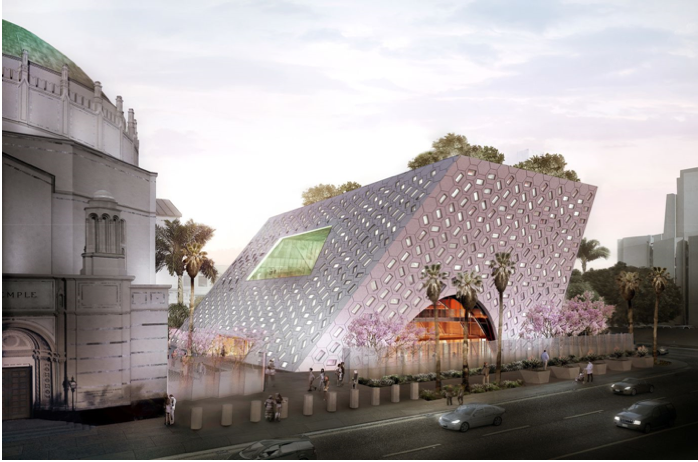CommentsDEEGAN ON LA—Koreatown is about to get a wake-up call that may have plenty of people talking when it becomes the stage upon which Dutch architect Rem Koolhaas, among the most acclaimed architects in the world, showcases his attention-getting work.
This time it’s for an addition to the Wilshire Boulevard Temple campus, home to a temple dedicated in 1929 for a congregation founded in 1862 as Congregation B’nai B’rith.
With this project, the old and the very new will be juxtaposed in a non-secular expression of how contemporary architecture can be successful in a city where NIMBYism often tries to prevent new styles from displacing the old.
What can the neighbors say, besides, “wow!” There hasn’t been much in the way of challenges. A spokesperson from Wilshire Boulevard Temple told CityWatch, “The project is fully entitled as a result of approvals obtained back in 2011 for a comprehensive Site Plan Review for the whole block that the Wilshire Boulevard Temple sits on, including the Audrey Irmas Pavilion building. A full EIR was done and all CEQA findings have been made as a result of this approval.”
Not only K’town but all of Los Angeles will witness first-hand what architecture can be when distilled through the mind of a Pritzker Prize winning architect like Koolhaas when he builds his first project in LA -- one that may become as “iconic” as Frank Gehry’s Disney Hall. When the addition opens in 2020, it will be Koolhaas’ first cultural building in California. Groundbreaking is projected for late 2018.
The Koolhaas vision for the 55,000-square-foot Audrey Irmas Pavilion will be what he is calling “three distinct gathering spaces that ‘puncture’ through the building -- a main event space, a smaller multi-purpose room, and a sunken garden. The three interlocking gathering spaces are stacked one atop another to establish vantage points and framed views in and out of each space while creating a series of openings that filter light and reorient visitors to the complex and beyond.”
We came close to having a Koolhaas a few miles west of K’town on Wilshire seventeen years ago when his OMA, Office of Metropolitan Architecture, won a design competition to create an ambitious $400-million project heralding the “new LACMA.”
The brilliant, art-education-paradigm-breaking design by Koolhaas for that project would have changed how we learn about and respect art history by having the paintings and objects grounded on two axes, one running the length of the building for the time period from ancient to contemporary, and the other, a series of criss-crosses for the various art movements. With it, you could stand at the year 1500 CE, for example, and view art in that period from not only the European Renaissance, but also Latin America, Asia, Africa and other centers of art. It would have democratized art by placing Western Art in a global context and demonstrating how parochial it can be to accept that one style of art was the leading, if not the only, art movement worth studying for that time period.
Like many great ideas, and a few Koolhaas projects -- some say there are more Koolhaas coffee table books than finished projects -- the funding was not available to reach the level to which Koolhaas’ vision for LACMA soared. Eli Broad was on the selection committee when LACMA awarded the design to Koolhaas many years ago. (Coincidentally, he was also on the Wilshire Boulevard Temple selection committee that chose Koolhaas.) There was an expectation that Broad would be one of the “lead gifts” at LACMA, but he wound up alone, frustrated, famously declaring to the LA Timeswhen the building campaign stalled before shutting down, "I can't do it alone...where does all the rest come from?"
Funding does not now appear to be a barrier to finally getting a Koolhaas building in Los Angeles. The Wilshire Boulevard Temple says they have raised $55 million toward the estimated $75 million budget for the new building, from a broad base of donors in a campaign that was kicked off in 2015 with a $30-million “lead gift” by Audrey Irmas, who will have her name on the new pavilion.
This building may become liminal to turning Koreatown into a place that attracts other top architects with signature designs that will help to animate K’town, already the densest neighborhood in the city, and one that is rapidly being torn down and redeveloped. It is architecture people will talk about and that will add substance to the urban landscape. Koolhaas may help transform Koreatown into an architecturally interesting neighborhood if his “lead project” is followed by other adventuresome architects, builders and developers.
The choice of Koolhaas by the Temple goes beyond the density and NIMBYism arguments. It is rooted in a whole different level of aesthetics, a consideration of what architecture can do to infuse a community, how it can powerfully affect our moods through elements like space, light, geometry and materials used. It won’t hurt for K’town (not to mention the Temple) to also have the bragging rights associated with such iconic architecture in its community.
Soon, not only Koreatown, but all of Los Angeles will have its own Rem Koolhaas for everyone to enjoy.
(Tim Deegan, is a civic activist whose DEEGAN ON LA weekly column about city planning, new urbanism, the environment, and the homeless appear in CityWatch. Tim can be reached at [email protected].) Edited for CityWatch by Linda Abrams.
















